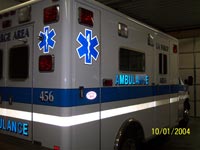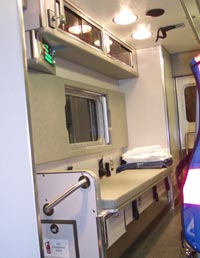 |
||||
      |
||||
|
The ambulance raced down the highway before turning onto a county road to reach its secluded destination. It was a race against time as the machine came to a halt at the edge of the scene. Waiting was a tractor, ready to transport La Farge Area Ambulance Service Volunteer Emergency Medical Technicians (EMTs) Bonita Dorschied and Skip Oliphant to a patient who was experiencing heart problems while repairing a fence in the woods. Dorschied jumped on one side of the tractor, holding an oxygen tank, while Oliphant latched onto the other, carrying the squad’s jump kit (a large bag with all the initial supplies necessary to assess a patient). Their worry for their safety warred with concerns about whether they had enough equipment for what awaited them in the woods near Yuba, Wisconsin. This particular story has a happy ending, enabling Dorschied to laugh as she recounts riding a tractor on an ambulance call. She says, “That’s rural America. Cities has to worry about different things. I like our scenario; it’s a little simpler. People know what rural EMT work is: you ride a tractor!” Dorschied and Oliphant are members of one of the few remaining volunteer ambulance squads in Wisconsin. The La Farge Area Ambulance Service (LAAS) is composed of 16 certified EMTs, as well as two drivers who are certified first responders. The oldest volunteer is 83 years old and the youngest is 22. The members have diverse interests and occupations, but they all care about helping people out. They are everyday, community-oriented individuals who have taken on the extracurricular role of hero. These people work full time, then choose to go on volunteer responses in their free time. At 22-years-old, Greg Lawton is the newest and youngest volunteer member of the LAAS. According to Lawton, “We sacrifice many social and family events to go out and help people. We are [often] asked to drop what we are doing or get up in the night to help. Each time the pager goes off we must be prepared to handle anything, anytime.” Bonita Dorschied, member of the squad since 1992 and full-time high school math teacher at La Farge High School, says the most challenging part of being on the squad is “being able to go at any time because you have so many other commitments.” Sometimes, members just don’t have the five hours necessary to go on a call. Fellow squad member Zach Fronk, 22, agrees. “A lot of calls come in and I can’t go because I won’t get back in time to go to work,” says Fronk. However, being an EMT Basic demands a great deal of time above and beyond calls: 140 hours of initial training with re-certification every six months in Advanced Airway and defibrillator training. Once a year, C.P.R. skills and medical training need to be re-certified. A 30-hour refresher course for all skills and concepts is mandatory every two years as well. For obvious reasons, the squad struggles to recruit members whose lives and schedules are flexible enough to handle the commitment. Yet, for some, the pluses outweigh the minuses. In 1999 when Zach Fronk decided to join the ambulance squad, he was a 17-year-old high school senior who wanted to make a difference in his community. “I enjoy helping people and this was an opportunity for me to do that,” says Fronk. Fronk took night classes along with his course load at La Farge High School in order to become a certified EMT. “This was somewhat of a challenge because it was something I wanted to do, something fun, something I actually enjoyed,” says Fronk. Dorschied feels the same way. She has always liked nursing and working with the sick, so she saw this as her opportunity to help out. “You have to be part of the community; you want to be,” Dorschied says. After 12 years, these feelings haven’t changed, and neither have Fronk’s: he wishes he would have joined sooner.
|
||
|
|||
|
|||
|
|||
|
|||


